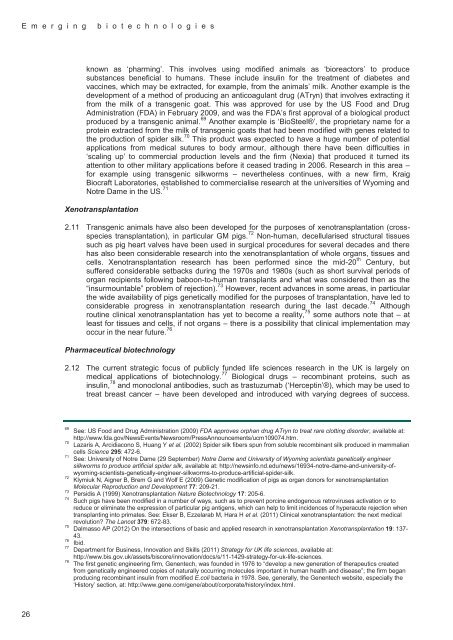Emerging biotechnologies: full report - Nuffield Council on Bioethics
Emerging biotechnologies: full report - Nuffield Council on Bioethics
Emerging biotechnologies: full report - Nuffield Council on Bioethics
Create successful ePaper yourself
Turn your PDF publications into a flip-book with our unique Google optimized e-Paper software.
E m e r g i n g b i o t e c h n o l o g i e s<br />
known as ‘pharming’. This involves using modified animals as ‘bioreactors’ to produce<br />
substances beneficial to humans. These include insulin for the treatment of diabetes and<br />
vaccines, which may be extracted, for example, from the animals’ milk. Another example is the<br />
development of a method of producing an anticoagulant drug (ATryn) that involves extracting it<br />
from the milk of a transgenic goat. This was approved for use by the US Food and Drug<br />
Administrati<strong>on</strong> (FDA) in February 2009, and was the FDA’s first approval of a biological product<br />
produced by a transgenic animal. 69 Another example is ‘BioSteel®’, the proprietary name for a<br />
protein extracted from the milk of transgenic goats that had been modified with genes related to<br />
the producti<strong>on</strong> of spider silk. 70 This product was expected to have a huge number of potential<br />
applicati<strong>on</strong>s from medical sutures to body armour, although there have been difficulties in<br />
‘scaling up’ to commercial producti<strong>on</strong> levels and the firm (Nexia) that produced it turned its<br />
attenti<strong>on</strong> to other military applicati<strong>on</strong>s before it ceased trading in 2006. Research in this area –<br />
for example using transgenic silkworms – nevertheless c<strong>on</strong>tinues, with a new firm, Kraig<br />
Biocraft Laboratories, established to commercialise research at the universities of Wyoming and<br />
Notre Dame in the US. 71<br />
Xenotransplantati<strong>on</strong><br />
2.11 Transgenic animals have also been developed for the purposes of xenotransplantati<strong>on</strong> (crossspecies<br />
transplantati<strong>on</strong>), in particular GM pigs. 72 N<strong>on</strong>-human, decellularised structural tissues<br />
such as pig heart valves have been used in surgical procedures for several decades and there<br />
has also been c<strong>on</strong>siderable research into the xenotransplantati<strong>on</strong> of whole organs, tissues and<br />
cells. Xenotransplantati<strong>on</strong> research has been performed since the mid-20 th Century, but<br />
suffered c<strong>on</strong>siderable setbacks during the 1970s and 1980s (such as short survival periods of<br />
organ recipients following babo<strong>on</strong>-to-human transplants and what was c<strong>on</strong>sidered then as the<br />
“insurmountable” problem of rejecti<strong>on</strong>). 73 However, recent advances in some areas, in particular<br />
the wide availability of pigs genetically modified for the purposes of transplantati<strong>on</strong>, have led to<br />
c<strong>on</strong>siderable progress in xenotransplantati<strong>on</strong> research during the last decade. 74 Although<br />
routine clinical xenotransplantati<strong>on</strong> has yet to become a reality, 75 some authors note that – at<br />
least for tissues and cells, if not organs – there is a possibility that clinical implementati<strong>on</strong> may<br />
occur in the near future. 76<br />
Pharmaceutical biotechnology<br />
2.12 The current strategic focus of publicly funded life sciences research in the UK is largely <strong>on</strong><br />
medical applicati<strong>on</strong>s of biotechnology. 77 Biological drugs – recombinant proteins, such as<br />
insulin, 78 and m<strong>on</strong>ocl<strong>on</strong>al antibodies, such as trastuzumab (‘Herceptin’®), which may be used to<br />
treat breast cancer – have been developed and introduced with varying degrees of success.<br />
69<br />
70<br />
71<br />
72<br />
73<br />
74<br />
75<br />
76<br />
77<br />
78<br />
See: US Food and Drug Administrati<strong>on</strong> (2009) FDA approves orphan drug ATryn to treat rare clotting disorder, available at:<br />
http://www.fda.gov/NewsEvents/Newsroom/PressAnnouncements/ucm109074.htm.<br />
Lazaris A, Arcidiac<strong>on</strong>o S, Huang Y et al. (2002) Spider silk fibers spun from soluble recombinant silk produced in mammalian<br />
cells Science 295: 472-6.<br />
See: University of Notre Dame (29 September) Notre Dame and University of Wyoming scientists genetically engineer<br />
silkworms to produce artificial spider silk, available at: http://newsinfo.nd.edu/news/16934-notre-dame-and-university-ofwyoming-scientists-genetically-engineer-silkworms-to-produce-artificial-spider-silk.<br />
Klymiuk N, Aigner B, Brem G and Wolf E (2009) Genetic modificati<strong>on</strong> of pigs as organ d<strong>on</strong>ors for xenotransplantati<strong>on</strong><br />
Molecular Reproducti<strong>on</strong> and Development 77: 209-21.<br />
Persidis A (1999) Xenotransplantati<strong>on</strong> Nature Biotechnology 17: 205-6.<br />
Such pigs have been modified in a number of ways, such as to prevent porcine endogenous retroviruses activati<strong>on</strong> or to<br />
reduce or eliminate the expressi<strong>on</strong> of particular pig antigens, which can help to limit incidences of hyperacute rejecti<strong>on</strong> when<br />
transplanting into primates. See: Ekser B, Ezzelarab M, Hara H et al. (2011) Clinical xenotransplantati<strong>on</strong>: the next medical<br />
revoluti<strong>on</strong>? The Lancet 379: 672-83.<br />
Dalmasso AP (2012) On the intersecti<strong>on</strong>s of basic and applied research in xenotransplantati<strong>on</strong> Xenotransplantati<strong>on</strong> 19: 137-<br />
43.<br />
Ibid.<br />
Department for Business, Innovati<strong>on</strong> and Skills (2011) Strategy for UK life sciences, available at:<br />
http://www.bis.gov.uk/assets/biscore/innovati<strong>on</strong>/docs/s/11-1429-strategy-for-uk-life-sciences.<br />
The first genetic engineering firm, Genentech, was founded in 1976 to “develop a new generati<strong>on</strong> of therapeutics created<br />
from genetically engineered copies of naturally occurring molecules important in human health and disease”; the firm began<br />
producing recombinant insulin from modified E.coli bacteria in 1978. See, generally, the Genentech website, especially the<br />
‘History’ secti<strong>on</strong>, at: http://www.gene.com/gene/about/corporate/history/index.html.<br />
26
















